What is the first thing that comes to your mind when you hear Cinco de Mayo?
Frequently, we hear the answer is, “beer and celebrations”.
Every year, local markets, stores, and bars flood with large quantities of advertisements by the alcohol industry, cheapening Cinco de Mayo with promotions that reduce it to nothing more than a drinking holiday and inviting everyone to “be Mexican for a day.”
What is the first thing that comes to your mind when you hear Cinco de Mayo?
Frequently, we hear the answer is, “beer and celebrations”.
Every year, local markets, stores, and bars flood with large quantities of advertisements by the alcohol industry, cheapening Cinco de Mayo with promotions that reduce it to nothing more than a drinking holiday and inviting everyone to “be Mexican for a day.”
As members of the Mount Miguel High School East County Youth Coalition, a local group of high school students who work to increase their communities health and safety by reducing underage drinking and drug use in East County, we are offended by how the alcohol industry is targeting our communities and exploiting a culture to send the wrong message to youth.
First things, let’s clarify what Cinco de Mayo (“the fifth of May”) really is. It is not Mexican Independence Day. That would be September 16. It is the holiday that owes its origins to the Battle of Puebla on May 5, 1862, when a small Mexican army defeated the invading French army under the rule of Emperor Napoleon III. It was a very strong army undefeated in battle for 50 years.
During the 1980s, the alcohol industry began marketing this day to promote alcohol consumption among the U.S. adult population, especially young adults.
This focused effort served the alcohol industry well, Cinco de Mayo brings in $635 billion every year in revenue sales.
Linking Cinco de Mayo with alcohol sends a dangerous message. Instead, of historical and national pride to the date, advertisements suggest to youth that an essential part of Latino culture and identity is to consume and abuse alcohol.
Decades of research show that greater exposure to alcohol advertising contributes to an increase in drinking among people under 21.
Alarmingly Hispanic youth are particularly affected by such advertising. Hispanic youth are more likely than non-Hispanic peers to start drinking before age 13, according to the 2013 national Youth Risk Behavior Survey.
More young people are seeing alcohol ads today than ever before. Among all racial groups, youth exposure to alcohol ads on television jumped 48 percent from 2009 to 2013, according to Center on Alcohol Marketing and Youth at Georgetown University.
The message to the alcoholic beverage industry is quite simple: Stop promotions that include messages which encourage heavy alcohol consumption and underage drinking, and stop using advertising campaigns that demean the Mexican culture.
Instead let’s engage in alcohol-free Cinco de Mayo festivals. Cinco de Mayo signifies cultural pride and celebrates the rights of people everywhere to enjoy the fruit of self-determination.
Above all, this date represents a symbol of Mexican and Latin American unity and patriotism.














